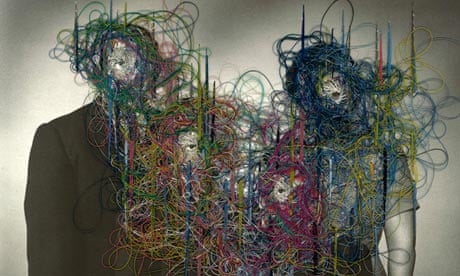We are used to viewing a photograph as an end result. But what if a photo is used as just the starting point of another creative process? Is it still a photograph? This is one of the questions prompted by the beautifully strange artworks of Maurizio Anzeri, who intricately embroiders found photographs with coloured thread. An exhibition of his work, But It's Not Late It's Only Dark, is currently on show at Chapter as part of the Diffusion photography festival in Cardiff.
The Italian-born, British-based Anzeri searches out vintage portraits in flea markets and junk shops, viewing them, he says, as landscapes on which to map out his own unique geography of suggestion. Faces are criss-crossed with coloured skeins, or patterned in curves and circles until they are barely visible. Sometimes the end result resembles an elaborate mask; at other times an interior landscape made by a latterday surrealist plundering his fertile unconscious. Here, the poignancy that attends all discarded photographs – remnants of another time, another life of which we know nothing – is literally covered over.
Anzeri has said that his embroidered images suggest "other possible evolutionary dimensions for the people pictured", but his work has a surrealist rather than a Darwinian undertow. Sombre-looking children and sophisticated adults take on an absurdist aspect. The people pictured all but disappear in the process, becoming shadows or outlines beneath the lines. What was once a portrait is something else entirely: a formal, sculptural, diagrammatic artwork in which identity and expression is camouflaged. Anzeri creates something new and surprising by applying an old-fashioned craft to old-fashioned artefacts.

The British artist Julie Cockburn also uses embroidery to alter found photographs, though her technique is often more wilfully childlike. She also applies marker pen, correction fluid and geometric plastic shapes that she finds in old toys and games from the 1960s and 70s. Where Anzeri uses Christian names as his titles – Giovanni, Peter, Angelo – Cockburn is more mischievous, calling a woman whose head has been covered in an embroidered net The Beekeeper. Another woman, whose face is concealed by what looks like long swathes of ice-cream coloured felt, has been rechristened Madame Gelati.
Cockburn's embroidery can make her found subjects look as though their heads have been encased in a 3D geometric sculpture or simply scrawled over. One of my favourite images is entitled The Funster: a cheeky-looking boy whose head, eyes and mouth have been encircled roughly in what looks like Tippex but on closer inspection turns out to be carefully applied embroidery in white thread. Cockburn also cuts up her portraits to kaleidoscopic effect, making a child on a sofa look like a small explosion of triangle entitled Tantrum.
I am intrigued, too, by her landscapes, where circles of coloured embroidery pattern a river valley or outline a small boat on a grey sea, making it look like a bleached-out John Hinde postcard. Her work is full of echoes, both artistic and everyday, and is less tied to surrealism than Anzeri's, having its roots in a more English vernacular tradition. A recent book of her work is intriguingly called Conversations, hinting at the way she brings found photographs back to life as something new. Both artists are making old photographs live again, in work that is not quite photography but has the photograph at its heart.
Now see this
As mentioned above, the Diffusion photography festival is underway in Cardiff, featuring events, talks and exhibitions, including work by Edgar Martins, Elin Høyland, Helen Sear and Holly Davey. Until 31 May.
Belfast Exposed is hosting a group exhibition, Northern Ireland: 30 Years of Photography, featuring work by Paul Seawright, Donovan Wylie, Sylvia Grace Borda, John Duncan, Mary McIntyre and Victor Sloan.
From Julia Margaret Cameron to Gregory Crewdson, the V&A traces the trajectory of "untruthful" photography in Making It Up: Photographic Fictions.

Comments (…)
Sign in or create your Guardian account to join the discussion